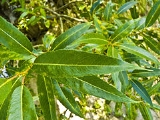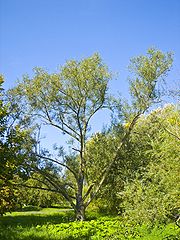
Crack Willow
Encyclopedia
Salix fragilis is a species of willow
native to Europe
and western Asia
, usually growing beside rivers.
 It is a medium-sized to large deciduous
It is a medium-sized to large deciduous
tree
, which grows rapidly to 10–20 m (rarely to 29 m) tall, with a trunk up to 1 m diameter and an irregular, often leaning crown. The bark
is grey-brown, coarsely fissured in older trees. The leaves
are bright green, 9–15 cm long and 1.5–3 cm wide, with a finely serrated margin; they are very finely hairy at first in spring, but soon become hairless. The flower
s are produced in catkin
s in early spring, and pollinated by insect
s. They are dioecious
, with male and female catkins on separate trees; the male catkins are 4–6 cm long, the female catkins also 4–6 cm long, with the individual flowers having either one or two nectaries.
The variety Salix fragilis var. decipiens (Hoffm.) K.Koch occurs frequently with the type; it is a smaller shrub
by tree, rarely exceeding 5–7 m tall, with completely hairless leaves up to 9 cm long and 2–3 cm broad. According to some botanists, it is a distinct species (treated as Salix decipiens Hoffm.), with, in this view, S. fragilis then being a hybrid between Salix decipiens and Salix alba. Some other botanists regard Salix decipiens as itself being a hybrid between Salix fragilis and Salix triandra
. There is little evidence to support either of these suggestions.
It readily forms natural hybrids with White Willow Salix alba, the hybrid being named Salix × rubens Schrank.
s which break off very easily and cleanly at the base with an audible crack. The broken twigs and branches take root readily, enabling the species to colonise new areas, where the broken twigs fall into rivers and can be carried some distance downstream. It is particularly adept at colonising new riverside sandbanks formed after flood
s.
Salix fragilis 'Russelliana' (syn. S. fragilis var. russelliana (Sm.) Koch) is by far the commonest clone of Crack Willow in Great Britain
and Ireland
, very easily propagated by cuttings. It is a vigorous tree commonly reaching 20–25 m tall, with leaves up to 15 cm long. It is a female clone.
in New Zealand
and is listed on the National Pest Plant Accord
, which means that it cannot be sold or distributed. S. fragilis is also an invasive species
in South Africa
.
Willow
Willows, sallows, and osiers form the genus Salix, around 400 species of deciduous trees and shrubs, found primarily on moist soils in cold and temperate regions of the Northern Hemisphere...
native to Europe
Europe
Europe is, by convention, one of the world's seven continents. Comprising the westernmost peninsula of Eurasia, Europe is generally 'divided' from Asia to its east by the watershed divides of the Ural and Caucasus Mountains, the Ural River, the Caspian and Black Seas, and the waterways connecting...
and western Asia
Asia
Asia is the world's largest and most populous continent, located primarily in the eastern and northern hemispheres. It covers 8.7% of the Earth's total surface area and with approximately 3.879 billion people, it hosts 60% of the world's current human population...
, usually growing beside rivers.

Deciduous
Deciduous means "falling off at maturity" or "tending to fall off", and is typically used in reference to trees or shrubs that lose their leaves seasonally, and to the shedding of other plant structures such as petals after flowering or fruit when ripe...
tree
Tree
A tree is a perennial woody plant. It is most often defined as a woody plant that has many secondary branches supported clear of the ground on a single main stem or trunk with clear apical dominance. A minimum height specification at maturity is cited by some authors, varying from 3 m to...
, which grows rapidly to 10–20 m (rarely to 29 m) tall, with a trunk up to 1 m diameter and an irregular, often leaning crown. The bark
Bark
Bark is the outermost layers of stems and roots of woody plants. Plants with bark include trees, woody vines and shrubs. Bark refers to all the tissues outside of the vascular cambium and is a nontechnical term. It overlays the wood and consists of the inner bark and the outer bark. The inner...
is grey-brown, coarsely fissured in older trees. The leaves
Leaf
A leaf is an organ of a vascular plant, as defined in botanical terms, and in particular in plant morphology. Foliage is a mass noun that refers to leaves as a feature of plants....
are bright green, 9–15 cm long and 1.5–3 cm wide, with a finely serrated margin; they are very finely hairy at first in spring, but soon become hairless. The flower
Flower
A flower, sometimes known as a bloom or blossom, is the reproductive structure found in flowering plants . The biological function of a flower is to effect reproduction, usually by providing a mechanism for the union of sperm with eggs...
s are produced in catkin
Catkin
A catkin or ament is a slim, cylindrical flower cluster, with inconspicuous or no petals, usually wind-pollinated but sometimes insect pollinated . They contain many, usually unisexual flowers, arranged closely along a central stem which is often drooping...
s in early spring, and pollinated by insect
Insect
Insects are a class of living creatures within the arthropods that have a chitinous exoskeleton, a three-part body , three pairs of jointed legs, compound eyes, and two antennae...
s. They are dioecious
Plant sexuality
Plant sexuality covers the wide variety of sexual reproduction systems found across the plant kingdom. This article describes morphological aspects of sexual reproduction of plants....
, with male and female catkins on separate trees; the male catkins are 4–6 cm long, the female catkins also 4–6 cm long, with the individual flowers having either one or two nectaries.
The variety Salix fragilis var. decipiens (Hoffm.) K.Koch occurs frequently with the type; it is a smaller shrub
Shrub
A shrub or bush is distinguished from a tree by its multiple stems and shorter height, usually under 5–6 m tall. A large number of plants may become either shrubs or trees, depending on the growing conditions they experience...
by tree, rarely exceeding 5–7 m tall, with completely hairless leaves up to 9 cm long and 2–3 cm broad. According to some botanists, it is a distinct species (treated as Salix decipiens Hoffm.), with, in this view, S. fragilis then being a hybrid between Salix decipiens and Salix alba. Some other botanists regard Salix decipiens as itself being a hybrid between Salix fragilis and Salix triandra
Salix triandra
Salix triandra is a species of willow native to Europe and western and central Asia, from southeastern England east to Lake Baikal, and south to Spain and the Caucasus and Alborz mountains...
. There is little evidence to support either of these suggestions.
It readily forms natural hybrids with White Willow Salix alba, the hybrid being named Salix × rubens Schrank.
Ecology
The name derives from the twigTwig
A twig is a small thin terminal branch of a woody plant. Twigs are critically important in identification of trees, shrubs and vines, especially in wintertime. The buds on the twig are an important diagnostic characteristic, as are the abscission scars where the leaves have fallen away...
s which break off very easily and cleanly at the base with an audible crack. The broken twigs and branches take root readily, enabling the species to colonise new areas, where the broken twigs fall into rivers and can be carried some distance downstream. It is particularly adept at colonising new riverside sandbanks formed after flood
Flood
A flood is an overflow of an expanse of water that submerges land. The EU Floods directive defines a flood as a temporary covering by water of land not normally covered by water...
s.
Cultivation and uses
The cultivarCultivar
A cultivar'Cultivar has two meanings as explained under Formal definition. When used in reference to a taxon, the word does not apply to an individual plant but to all those plants sharing the unique characteristics that define the cultivar. is a plant or group of plants selected for desirable...
Salix fragilis 'Russelliana' (syn. S. fragilis var. russelliana (Sm.) Koch) is by far the commonest clone of Crack Willow in Great Britain
Great Britain
Great Britain or Britain is an island situated to the northwest of Continental Europe. It is the ninth largest island in the world, and the largest European island, as well as the largest of the British Isles...
and Ireland
Ireland
Ireland is an island to the northwest of continental Europe. It is the third-largest island in Europe and the twentieth-largest island on Earth...
, very easily propagated by cuttings. It is a vigorous tree commonly reaching 20–25 m tall, with leaves up to 15 cm long. It is a female clone.
Invasive species
S. fragilis is an invasive speciesInvasive species
"Invasive species", or invasive exotics, is a nomenclature term and categorization phrase used for flora and fauna, and for specific restoration-preservation processes in native habitats, with several definitions....
in New Zealand
New Zealand
New Zealand is an island country in the south-western Pacific Ocean comprising two main landmasses and numerous smaller islands. The country is situated some east of Australia across the Tasman Sea, and roughly south of the Pacific island nations of New Caledonia, Fiji, and Tonga...
and is listed on the National Pest Plant Accord
National Pest Plant Accord
The National Pest Plant Accord identifies pest plants that are prohibited from sale and commercial propagation and distribution across New Zealand....
, which means that it cannot be sold or distributed. S. fragilis is also an invasive species
Invasive species
"Invasive species", or invasive exotics, is a nomenclature term and categorization phrase used for flora and fauna, and for specific restoration-preservation processes in native habitats, with several definitions....
in South Africa
South Africa
The Republic of South Africa is a country in southern Africa. Located at the southern tip of Africa, it is divided into nine provinces, with of coastline on the Atlantic and Indian oceans...
.

